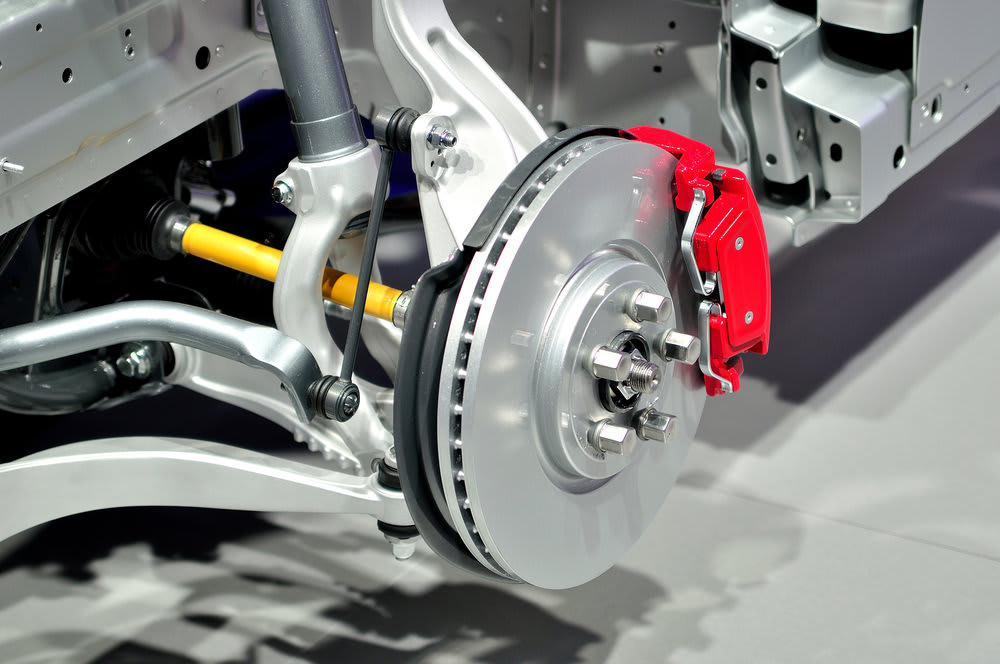

Most modern vehicles use a brake system comprised of disc brakes. They are called such because they use force applied upon discs attached to the wheels to slow and stop a car. Compared to drum brakes, disc brakes provide greater stopping power and don’t overheat as quickly under heavy use. While some entry-level vehicles use drum brakes on the rear wheels, four-wheel disc brakes are commonly found on everything from family sedans, to trucks, to high-performance sports cars.
Parts that make up the disc brake system
Rotor: Circular disc bolted to the wheel hub that spins with the wheel. Rotors are most commonly made of cast iron or steel, however some very high-end cars use a carbon ceramic rotor. Rotors can be slotted or drilled for better heat dissipation.
Brake pads: Component that pushes into the rotor, creating the friction that slows and stops a car. They feature a metal portion called a shoe and a lining that is attached to the shoe. The lining is what actually comes in contact with the rotor and wears away with use. Linings are made of different materials and fall into three categories: organic, semi-metallic and ceramic. The lining material chosen will impact the length of brake life, the amount of noise heard when the brakes are applied, and how quickly the brakes bring a car to a halt.
Piston: Cylinder connected to the brake system hydraulics. The piston is what moves the brake pads into the rotor when the driver presses the brake pedal. Some brake systems have a single piston that moves both pads, while others have two pistons that push the brake pads from each side of the rotor. Others still have four, six, or even eight pistons for higher braking power, at the expense of added cost and complexity.
Caliper: Housing that fits over the rotor and holds the brake pads and pistons, as well as contains ducting for brake fluid. There are two types of brake calipers: floating (or sliding) and fixed. Floating calipers “float” over the rotor, and only have pistons on a single side. When the driver presses the brakes, the pistons press the brake pads on one side into the rotor, which causes the caliper to slide over so that the pads on the non-piston side of the caliper also contact the rotor. Fixed calipers are bolted in place, and instead have pistons on both sides of the rotor that move when the driver applies the brakes. Fixed calipers apply brake pressure more evenly and clamp more firmly on the rotor, however floating calipers are found on most cars and are perfectly adequate for everyday driving.
Sensors: Some vehicles have brakes that contain sensors embedded in the brake pads which work to tell the driver when the pads are worn out. Other brake sensors play a part in the vehicle’s ABS system.
How disc brakes function
The brakes should respond instantly. When the driver presses the pedal, a piston inside the brake master cylinder pressurizes hydraulic fluid in the brake lines, which moves the pistons and pushes the pads into the rotor. The harder the driver pushes on the pedal, the greater the pressure inside the brake lines will be, and the harder the pads will squeeze the rotor. The distance the pads move is small – only a few millimeters – and should retract back into the calipers as soon as the driver lets off the pedal.
Wear and tear on disc brakes
Even in normal driving scenarios, disc brake systems deal with major stress and heat, and over time certain components will need to be replaced. The brake pads need replacement most frequently. When that happens depends on your particular driving habits as well as the material the pads are made of, but it ranges between 25,000 and 70,000 miles. Brake rotors often last between 50,000 and 70,000 miles (and sometimes more), but can become damaged if they overheat or if brake pads aren’t replaced on time. Brake fluid is the lifeblood of the whole brake system, so check it every 24,000 to 36,000 miles, or immediately if you suspect a leak. Pistons and calipers should last the lifetime of the vehicle, unless there is a mechanical problem, they are damaged by debris or in a crash, or if they seize due to inactivity.
Symptoms of problems with disc brakes
A few hard-to-ignore symptoms let a driver know there’s a problem with their brakes:
Squealing noise: As brake pad material wears away, a metal wear indicator inside the pad starts to come in contact with the rotor, producing a high-pitched squealing noise. Replacing the brake pads usually fixes the noise, but it may also be caused by road debris caught in the caliper.
Shaking or pulsating pedal: If the brake pedal pulsates or shakes when you press it, chances are your rotors are warped. Brake rotors are meant to be perfectly flat, and a warp can form by overuse or overheating. Rotors can sometimes be resurfaced to make them smooth again, although outright replacement is often a similarly-priced and safer option.
Spongy or low brake pedal: The brake pedal should have good feel, with braking force consistent with the amount of pressure applied to the pedal. If the pedal feels spongy or lower than usual, it’s often a sign of contaminated brake fluid or a leak in the system. Air or water in the fluid reduces its efficacy, and a leak is a serious problem. Have a mechanic flush the fluid or inspect the system for leaks to restore full braking power.
Brakes are arguably the most important safety system in any car, and disc brakes provide strong, reliable, and long-lasting braking performance. Chances are your car uses them, so stay aware of any unusual symptoms that could indicate a part needs to be replaced.



